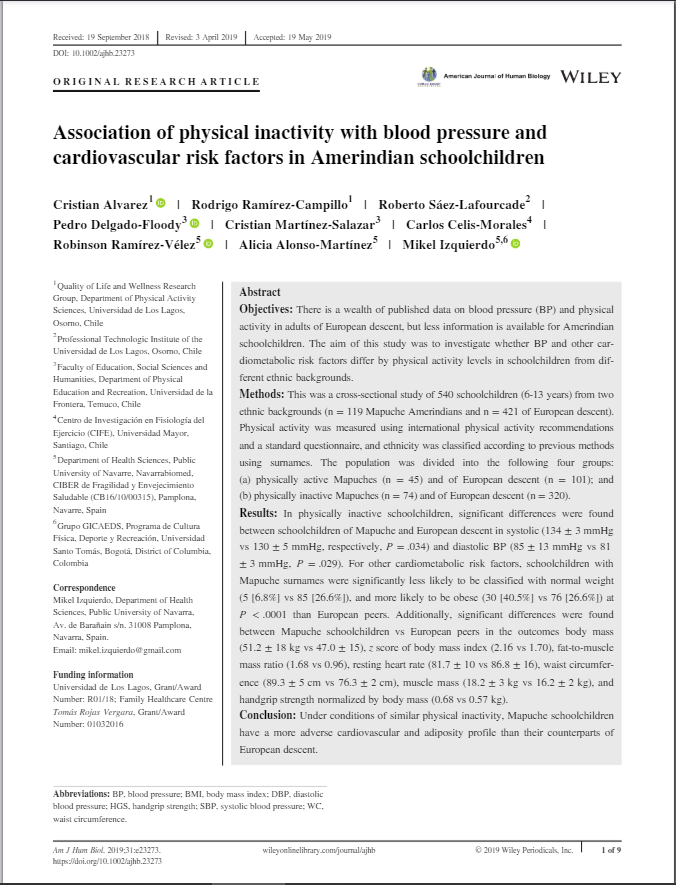Association of physical inactivity with blood pressure and cardiovascular risk factors in Amerindian schoolchildren

Fecha
2019Autor
Celis-Morales, Carlos [Univ Mayor, CIFE, Santiago, Chile]
Alvarez, Cristián
Ramírez-Campillo, Rodrigo
Saez-Lafourcade, Roberto
Delgado-Floody, Pedro
Martínez-Salazar, Cristián
Ramírez-Velez, Robinson
Alonso-Martínez, Alicia
Izquierdo, Mikel
Ubicación geográfica
Notas
HERRAMIENTAS
Acceda a títulos restringidos
¿Cómo descargar?Resumen
Objectives There is a wealth of published data on blood pressure (BP) and physical activity in adults of European descent, but less information is available for Amerindian schoolchildren. The aim of this study was to investigate whether BP and other cardiometabolic risk factors differ by physical activity levels in schoolchildren from different ethnic backgrounds. Methods This was a cross-sectional study of 540 schoolchildren (6-13 years) from two ethnic backgrounds (n = 119 Mapuche Amerindians and n = 421 of European descent). Physical activity was measured using international physical activity recommendations and a standard questionnaire, and ethnicity was classified according to previous methods using surnames. The population was divided into the following four groups: (a) physically active Mapuches (n = 45) and of European descent (n = 101); and (b) physically inactive Mapuches (n = 74) and of European descent (n = 320). Results In physically inactive schoolchildren, significant differences were found between schoolchildren of Mapuche and European descent in systolic (134 +/- 3 mmHg vs 130 +/- 5 mmHg, respectively, P = .034) and diastolic BP (85 +/- 13 mmHg vs 81 +/- 3 mmHg, P = .029). For other cardiometabolic risk factors, schoolchildren with Mapuche surnames were significantly less likely to be classified with normal weight (5 [6.8%] vs 85 [26.6%]), and more likely to be obese (30 [40.5%] vs 76 [26.6%]) at P < .0001 than European peers. Additionally, significant differences were found between Mapuche schoolchildren vs European peers in the outcomes body mass (51.2 +/- 18 kg vs 47.0 +/- 15), z score of body mass index (2.16 vs 1.70), fat-to-muscle mass ratio (1.68 vs 0.96), resting heart rate (81.7 +/- 10 vs 86.8 +/- 16), waist circumference (89.3 +/- 5 cm vs 76.3 +/- 2 cm), muscle mass (18.2 +/- 3 kg vs 16.2 +/- 2 kg), and handgrip strength normalized by body mass (0.68 vs 0.57 kg). Conclusion Under conditions of similar physical inactivity, Mapuche schoolchildren have a more adverse cardiovascular and adiposity profile than their counterparts of European descent.
Coleccion/es a la/s que pertenece:
Si usted es autor(a) de este documento y NO desea que su publicación tenga acceso público en este repositorio, por favor complete el formulario aquí.